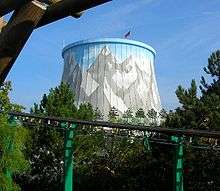SNR-300
.jpg)

The Fast Breeder sodium cooled[1] nuclear reactor SNR-300 was built near the town of Kalkar, North Rhine-Westphalia, Germany. It was completed but never taken online. SNR-300 was to output 327 megawatts. The project cost about 7 billion Deutsche Mark (about 3.5 billion euros or over 4 billion USD). Klaus Traube, then director of the executing company Interatom, is today one of the most prominent German opponents of the usage of nuclear power.
Planning
In late 1972, Germany, Belgium and the Netherlands charged the Siemens subsidiary Interatom to build a fast breeder - still a very new technology at the time. The German government wanted to limit energy import, and, as the uranium supply in Germany was limited, a breeder facility to use the limited resources efficiently was required. The building commenced at the end of the same year.
Bundeskanzler (chancellor) at that time was Willy Brandt (SPD); head of the Bundesministerium für Wirtschaft und Technologie were Karl Schiller (until 7. July 1972) and Helmut Schmidt (until the end of the cabinet (15. Dezember 1972).
Other
In France, CEA and EDF built Phénix from 1968; it started in December 1973. It was a pool-type liquid-metal fast breeder reactor cooled with liquid sodium and a small-scale (gross 264/net 233 MWe) prototype fast breeder reactor, located at the Marcoule nuclear site, near Orange, France.
Phénix had to be stopped each two months to be refueled. Between 1990 and 1996, it was run sporadically.
Thus, France had a long-term head start. Problems of Phénix became known; this made it less attractive to do FBT research. When the subsequent full-scale prototype Superphénix started in 1986, it increased the idea that the time for a FBT prototype was over.
Timeline
- 1972: The project commences.
- April 25, 1973: foundation stone ceremony
- October 16, 1973: the first oil crisis begins
- after a 20-year career in the nuclear industry, Klaus Traube (CEO of Interatom) is illegally eavesdropped by the Bundesamt für Verfassungsschutz. He is dismissed and starts as an activist against nuclear power. The eavesdropping becomes known 28. February 1977[2]
- 1977: Increasing public doubt about the safety of nuclear energy culminates in the first demonstration, involving about 40,000 people marching in the streets of Kalkar.
- March 28, 1979: Three Mile Island suffers a partial meltdown and a local anti-nuclear movement causes open questioning of the project. This discussion leads to an inquiry by a commission of the Bundestag. Building is interrupted for 4 years as the commission concludes that the safety of the facility needs to be upgraded in light of the difficult to control process of fast breeders, along with concerns about the coolant (sodium, which, when brought into contact with water, explodes). The interruption along with the redesign of the safety features raise the costs of the project significantly. The local state government (= the government of North Rhine-Westphalia) turns against the project.
- 1982: Bundeskanzler Helmut Schmidt (SPD) is followed by Helmut Kohl (CDU).
- 1985: SNR-300 is completed. The reactor is taken into partial operation. The sodium coolant is already running through the coolant loop and has to be kept hot using electric heating elements so it does not solidify. The reactor is ready to receive nuclear materials. In this phase, the running costs are already more than 5 million euros per month. The state government (which has authority in matters of nuclear power and environmental issues) blocks the opening of the plant, against the wishes of the federal government. As elections are coming up (Bundestagswahl 25. January 1987), the German government unofficially decide not to take SNR-300 into operation just yet.
At this point neither the country government, nor the local state government (MP from 1978-1998 was Johannes Rau) want the facility to become operational. Plans for a second facility, SNR-2, planned to produce 1,500 megawatts, are officially cancelled around this time.
- 26. April 1986: Chernobyl disaster.
- 1991: The official cancellation of the SNR-300 is offered on 21 March. The demolition of parts of the facility costs another 75 million euros. The unused machinery is put on sale. The reactor core is transferred to storage elsewhere. The breeder material, already bought for the operation of the facility, is transferred to France where it is mixed into MOX fuel, which is used by a number of France's nuclear reactors.
- early 1990s: 12 unused blanket fuel assemblies from SNR-300, containing depleted uranium, were transferred to James Acord and housed at Hanford Nuclear Reservation.[3]
- 1995: The facility is put up for auction by way of an announcement in the newspapers. The Dutch investor/developer Hennie van der Most buys the property for 2.5 million euros. The site is transformed into an amusement park named Kernwasser Wunderland ("Corewater Wonderland"). It includes a hotel with 400 beds. In 2005 it was renamed into Wunderland Kalkar ("Wonderland Kalkar").
References
External links
| Wikimedia Commons has media related to Kalkar Nuclear Power Plant. |
Coordinates: 51°45′47″N 6°19′37″E / 51.76306°N 6.32694°E